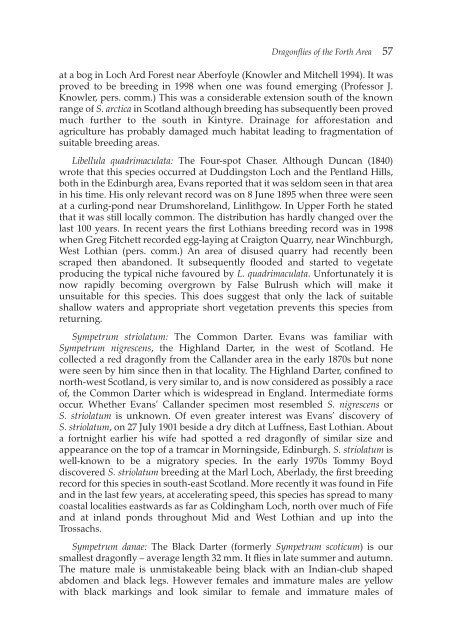the Forth Naturalist Historian - Forth Naturalist and Historian ...
the Forth Naturalist Historian - Forth Naturalist and Historian ...
the Forth Naturalist Historian - Forth Naturalist and Historian ...
You also want an ePaper? Increase the reach of your titles
YUMPU automatically turns print PDFs into web optimized ePapers that Google loves.
Dragonflies of <strong>the</strong> <strong>Forth</strong> Area 57<br />
at a bog in Loch Ard Forest near Aberfoyle (Knowler <strong>and</strong> Mitchell 1994). It was<br />
proved to be breeding in 1998 when one was found emerging (Professor J.<br />
Knowler, pers. comm.) This was a considerable extension south of <strong>the</strong> known<br />
range of S. arctica in Scotl<strong>and</strong> although breeding has subsequently been proved<br />
much fur<strong>the</strong>r to <strong>the</strong> south in Kintyre. Drainage for afforestation <strong>and</strong><br />
agriculture has probably damaged much habitat leading to fragmentation of<br />
suitable breeding areas.<br />
Libellula quadrimaculata: The Four-spot Chaser. Although Duncan (1840)<br />
wrote that this species occurred at Duddingston Loch <strong>and</strong> <strong>the</strong> Pentl<strong>and</strong> Hills,<br />
both in <strong>the</strong> Edinburgh area, Evans reported that it was seldom seen in that area<br />
in his time. His only relevant record was on 8 June 1895 when three were seen<br />
at a curling-pond near Drumshorel<strong>and</strong>, Linlithgow. In Upper <strong>Forth</strong> he stated<br />
that it was still locally common. The distribution has hardly changed over <strong>the</strong><br />
last 100 years. In recent years <strong>the</strong> first Lothians breeding record was in 1998<br />
when Greg Fitchett recorded egg-laying at Craigton Quarry, near Winchburgh,<br />
West Lothian (pers. comm.) An area of disused quarry had recently been<br />
scraped <strong>the</strong>n ab<strong>and</strong>oned. It subsequently flooded <strong>and</strong> started to vegetate<br />
producing <strong>the</strong> typical niche favoured by L. quadrimaculata. Unfortunately it is<br />
now rapidly becoming overgrown by False Bulrush which will make it<br />
unsuitable for this species. This does suggest that only <strong>the</strong> lack of suitable<br />
shallow waters <strong>and</strong> appropriate short vegetation prevents this species from<br />
returning.<br />
Sympetrum striolatum: The Common Darter. Evans was familiar with<br />
Sympetrum nigrescens, <strong>the</strong> Highl<strong>and</strong> Darter, in <strong>the</strong> west of Scotl<strong>and</strong>. He<br />
collected a red dragonfly from <strong>the</strong> Call<strong>and</strong>er area in <strong>the</strong> early 1870s but none<br />
were seen by him since <strong>the</strong>n in that locality. The Highl<strong>and</strong> Darter, confined to<br />
north-west Scotl<strong>and</strong>, is very similar to, <strong>and</strong> is now considered as possibly a race<br />
of, <strong>the</strong> Common Darter which is widespread in Engl<strong>and</strong>. Intermediate forms<br />
occur. Whe<strong>the</strong>r Evans’ Call<strong>and</strong>er specimen most resembled S. nigrescens or<br />
S. striolatum is unknown. Of even greater interest was Evans’ discovery of<br />
S. striolatum, on 27 July 1901 beside a dry ditch at Luffness, East Lothian. About<br />
a fortnight earlier his wife had spotted a red dragonfly of similar size <strong>and</strong><br />
appearance on <strong>the</strong> top of a tramcar in Morningside, Edinburgh. S. striolatum is<br />
well-known to be a migratory species. In <strong>the</strong> early 1970s Tommy Boyd<br />
discovered S. striolatum breeding at <strong>the</strong> Marl Loch, Aberlady, <strong>the</strong> first breeding<br />
record for this species in south-east Scotl<strong>and</strong>. More recently it was found in Fife<br />
<strong>and</strong> in <strong>the</strong> last few years, at accelerating speed, this species has spread to many<br />
coastal localities eastwards as far as Coldingham Loch, north over much of Fife<br />
<strong>and</strong> at inl<strong>and</strong> ponds throughout Mid <strong>and</strong> West Lothian <strong>and</strong> up into <strong>the</strong><br />
Trossachs.<br />
Sympetrum danae: The Black Darter (formerly Sympetrum scoticum) is our<br />
smallest dragonfly – average length 32 mm. It flies in late summer <strong>and</strong> autumn.<br />
The mature male is unmistakeable being black with an Indian-club shaped<br />
abdomen <strong>and</strong> black legs. However females <strong>and</strong> immature males are yellow<br />
with black markings <strong>and</strong> look similar to female <strong>and</strong> immature males of



